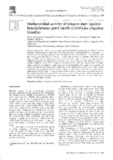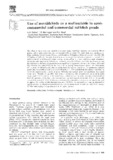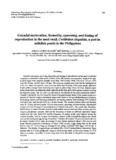| dc.contributor.author | Bagarinao, Teodora | |
| dc.contributor.author | Lantin-Olaguer, Imelda | |
| dc.date.accessioned | 2013-11-12T08:47:39Z | |
| dc.date.available | 2013-11-12T08:47:39Z | |
| dc.date.issued | 2000 | |
| dc.identifier.citation | Bagarinao, T., & Lantin-Olaguer, I. (2000). From triphenyltins to integrated management of the 'pest' snail Cerithidea cingulata in mangrove-derived milkfish ponds in the Philippines. Hydrobiologia, 437(1-3), 1-16. | en |
| dc.identifier.issn | 0018-8158 | |
| dc.identifier.uri | http://hdl.handle.net/10862/1718 | |
| dc.description.abstract | The potamidid snail Cerithidea cingulata is considered a pest in brackishwater milkfish ponds in the Philippines and has been controlled by the triphenyltin (TPT) compounds Aquatin and Brestan. But TPT is also toxic to other invertebrates, fishes, algae, bacteria and people, and high TPT residues occur in sea foods including milkfish. Thus, control of snails in milkfish ponds should be shifted from reliance on TPT to an integrated pest management (IPM) strategy. To formulate a responsible IPM, studies were conducted on C. cingulata in ponds and mangroves and the available data were synthesized with the relevant information from the literature. The deposit-feeding C. cingulata is a native resident of mangrove areas and becomes a problem in mangrove-derived ponds where the lack of competitors and predators results in 'ecological release' and population explosion. Snail densities ranged 1–470 m−2 in the mangroves and 100–5000 m−2 in ponds. In ponds, snails ranged 2–40 mm in shell length; those 25 mm long and 8 mm wide weighed 1 g on average, and had 150 mg flesh. Snails matured at 20 mm long and reproduced the whole year with a peak in Mar–Sep at water temperatures of 24–36 °C. Enriched sediments and stagnant water in ponds allowed fast growth and reproduction, low dispersal and high recruitment of snails. Snails were very tolerant to hypoxia and adverse conditions, but were killed within a week by sun-drying or by salinities of 48–70‰ and within 3 d by ammonium phosphate at 10 g l−1 or urea at 5 g l−1. IPM of snails requires changes in mind sets and perspectives of milkfish farmers and industry supporters and changes in farm practices and management. Snails must be viewed as a resource from which income can be made and employment can be generated. Harvest of snails for shellcraft and other enterprises also effectively removes the spawning population. Complete draining and sun-drying of ponds after harvest kills the adult snails and the egg strings on the bottom. Snails in puddles in the ponds may be killed by the usual nitrogen fertilizers and lime applied during pond preparation. Water input may be timed with periods of low veliger counts in the supply water. These IPM recommendations have yet to be verified. | en |
| dc.language.iso | en | en |
| dc.publisher | Kluwer Academic Publishers | en |
| dc.subject | Cerithidea cingulata | en |
| dc.subject | Philippines | en |
| dc.subject | Chanos chanos | en |
| dc.subject | Ecological release | en |
| dc.subject | Microbial mat | en |
| dc.title | From triphenyltins to integrated management of the 'pest' snail Cerithidea cingulata in mangrove-derived milkfish ponds in the Philippines | en |
| dc.type | Article | en |
| dc.citation.volume | 437 | |
| dc.citation.issue | 1-3 | |
| dc.citation.spage | 1 | |
| dc.citation.epage | 16 | |
| dc.citation.journalTitle | Hydrobiologia | en |
| dc.subject.asfa | aquaculture facilities | en |
| dc.subject.asfa | bioaccumulation | en |
| dc.subject.asfa | ponds | en |
| dc.subject.asfa | mangrove swamps | en |
| dc.subject.asfa | molluscicides | en |
| dc.subject.asfa | ecotoxicology | en |
| dc.subject.asfa | pest control | en |
| dc.subject.asfa | mangroves | en |
| dc.subject.asfa | pollutant persistence | en |
| dc.subject.asfa | pollution effects | en |
| dc.subject.asfa | tin compounds | en |
| dc.subject.asfa | water pollution | en |
| dc.identifier.doi | 10.1023/A:1026580726648 | |
| dc.subject.scientificName | Chanos chanos | |
| dc.subject.scientificName | Cerithidea cingulata | |
| dc.subject.scientificName | Pirenella cingulata | |



